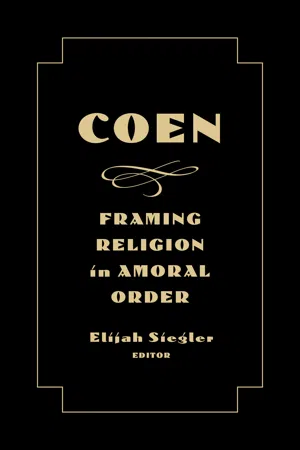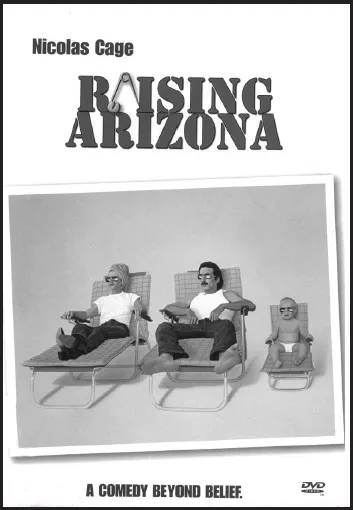![]()
1
Morality in Raising Arizona
ERIC MICHAEL MAZUR
In 1987 Joel and Ethan Coen released their second feature film, Raising Arizona, to mixed reviews.1 Hailed by some as a technical triumph, the movie was generally overlooked for its interpretive merit, and few movie analysts at the time—neither those who enjoyed the film nor those who did not—considered its structure too deeply, dismissing it as “just” a comedy. This was particularly true of scholars of religion and film who, despite some of the film’s marketing,2 did not consider it worthy of religious analysis. Consistent with a lack of attention paid to the genre of comedy in the scholarly study of religion and film, even now, nearly thirty years after its release, Raising Arizona has received scant serious religious consideration.3
But this film is more than just another screwball comedy.4 From the large gold “chai” [חי] dangling around the neck of prison counselor “Doc Schwartz” to the constant biblical references throughout the narration, the story seems worthy of attention for its religious significance. Narrated like a personal confession,5 this film presents a classic story of a man caught between the desire to do good and the temptation to do evil, following the model of a morality play that is centuries old. “The morality play,” observes David Bevington, “tells the story of a representative individual Christian.” It chooses a universal central figure who is surrounded “by abstract representations of his state of mind or body: Despair, Courage, Strength, Five Wits, and so on. He is counseled by his Good Angel and tempted by his Evil Angel, or by similar figures.” “Accordingly,” Bevington concludes, “allegory is central to the method of the morality play.”6 While Raising Arizona may not employ characters as explicitly identified as Temptation or Evil, they are clearly part of the narrative structure, and there is a moral to the story. But given the role of religion in contemporary America, it is no surprise that—with a viewing audience less and less familiar with the religious texts upon which this story is modeled—the religious nuances of Raising Arizona, and films like it, have, in the words of Herbert Gans, gone “in one eye and out the other.”7 What critics seem to have missed is that Raising Arizona is not a morality tale without a moral, but a morality tale about morality; a nonmoral morality tale.
“A comedy beyond belief . . .”
A Film about Nothing, or a Film about Nothing?
Many reviewers were highly critical of Raising Arizona. Sheila Benson wondered how the film could “move so fast, be so loud and remain so relentlessly boring at the same time”; John Simon, arguing that “no beast is as dumb as these characters,” considered Raising Arizona to be “an endlessly coarse, unendingly mindless film”; and Roger Ebert gave the movie one and one-half stars, exclaiming that it was “all over the map.”8 Janet Maslin suggested that the film “tells its story in a spirit of technical accomplishment rather than in the interests of narrative momentum,” concluding that “to the extent that films are about ideas, Raising Arizona isn’t about anything.”9
Of course, in the annals of film this description would not have made Raising Arizona unique; in hindsight, this might have made it representative of its time. Seinfeld (NBC, 1989–1998), one of the most popular television programs of the late 1980s and early 1990s, ultimately made a name for itself as “the show about nothing.”10 Reflecting specifically on Raising Arizona and Blood Simple (Joel and Ethan Coen’s first major release), Bruce Bawer suggests that, while “the films of the Coen brothers, for all their absurdity, nevertheless reflect an acute and pained awareness of the evil of which human beings are capable,” it might be futile “to suggest that the film is more serious than it is.”11 It is, after all, a comedy, and relies more on humor than on morality to deliver its message.
However, as we noted earlier, we should not be so quick to dismiss a film simply because it is a comedy; it is clearly a film about something. Richard Gilmore quotes Aristotle to define a comedy as “a narrative that begins in a bad place but, in its narrative unfolding, ends in a good place,” and cites as the classic example Dante Alighieri’s Divine Comedy.12 Raising Arizona seems to fit this description; in the beginning, Hi is a petty criminal with no hopes or dreams, but by the end of the film he is a married man with hopes (and certainly dreams) to be a patriarchal figure in a seemingly close, multigenerational family. This may explain why, given this structure, a number of critics argue that the film is about something. Joseph Meigs argues that the theme of the film is centered around
the interrelated ideas that childhood determines our adulthood, that proper parenting or the correct ‘raising’ process is crucial in the formation of a responsible individual, and that a bad childhood creates a dark side to a child that eventually comes back to haunt him as an adult.13
Rita Kemply puts it more directly, arguing that the film is about “having babies and taking hostages.”14 Somewhere in between is Ryan Doom, who notes that the film “examines the failed American family and the lost American dream, for which all a man desires is a wife, a job, and a family to raise.” He cites the “erosion of economics and family values, the rise of greed, and the chaos of violence created by it,” identifying Nathan Sr. as “capitalism gone wrong,” Smalls as the “end of America,” and Hi and Ed as the “dying American dream, attempting to build the ideal family.”15 There is little doubt that the film does critically examine the frantic desire to grab on to the American dream and its manifestations in parenthood, homeownership, and, as Hi notes wryly, all things “Ozzie and Harriet.”
The reference here to an America as represented by the long-running television program The Adventures of Ozzie and Harriet (ABC, 1952–1966) reflects the influence various forms of media had on the Coens as they constructed the world of Raising Arizona. To some critics, the most obvious influences were Saturday morning cartoons. Josh Levine notes that the Coens imagined the film “full of comic speeches and wild chase scenes in which they would take their inspiration from Chuck Jones’s Roadrunner cartoons.” He concludes that the choice of location “even owes something to the desert landscapes through which Wile E. Coyote eternally chased that beep-beeping bird,” while Carolyn Russell observes that “the showdown between Small [sic] and H.I. (a conflict between H.I.’s outlaw impulse and his nobler, more civilized, domesticated self) is a showcase of cartoon punishment.”16 This comparison has led several critics to mistake the tattoo shared by Hi and Smalls either for the popular television cartoon character the Road Runner or Woody Woodpecker.17 Levine suggests that “it might well be that television watching was the biggest influence of all” on the Coens.18
But the world of Raising Arizona does not depend solely on the Coen brothers’ knowledge of television; it echoes a number of earlier films great and small. From the graffiti painted on the men’s room door in the gas station where Gale and Evelle Snopes steal a car—possibly inspired by Dr. Strangelove (1964)—to Leonard Smalls’ “Mad Max” appearance, the use from The Night of the Hunter (1955) of the line “It’s a hard world for the little things,” and music reminiscent of the shark’s theme in Jaws (1975), Raising Arizona is a highly integrated interweaving of other filmic texts, leading one critic to label the Coens as “typical film-school products” who know “little about anything other than movies” and in whose films there is “no evidence . . . of exposure to any kind of culture or observation of humanity in any but the two-dimensional, celluloid form.”19
Nonsense. As with television and film, Raising Arizona is replete with references to great literature and observations of humanity. The narration and dialogue are brimming with biblical references, while the very first line of the film—“My name is H.I. McDunnough. Call me Hi”—parallels the familiar opening line from Herman Melville’s 1851 classic Moby-Dick.20 “Like Moby-Dick,” argues Erica Rowell, “Raising Arizona ponders age-old religious questions about creation, goodness, and evil, and both turn many a religious phrase,” leading her to ponder if Hi’s middle initial might actually stand for “Ishmael” (unlike Hi’s first name—“Herbert”—his middle name is never revealed in the film).21 Rodney Hill and Erica Rowell connect Leonard Smalls with John Steinbeck’s Of Mice and Men (1937), while Vincent Camby suggests that Gale and Evelle’s last name—Snopes—is “a jokey reminder of [William] Faulkner’s Yoknapatawpha County” (a point missed by two writers who mistake the name for “Snoats”).22 In justifying the baby-napping, Hi recalls Rudyard Kipling when he rationalizes that “there’s what’s right, and there’s what’s right, and nary the twain shall meet,” and Jeff Evans traces the image of the “wart hog from hell” to Flannery O’Connor in her short story “Revelation” (1965).23 There is even a healthy blend of classic and American “roots” music included in the soundtrack.24
Several critics note other aspects of Raising Arizona that emphasize a southern disposition. Paul Coughlin points out that McDunnough speaks with “the literacy and lucidity of a gifted Southern raconteur. . . . With Raising Arizona Joel and Ethan Coen take to extremes the image of the loquacious and conversationally dexterous Southerner.”25 Carolyn Russell observes that H.I. “speaks in a sweetly droning, pseudo-biblical, quasi-mournful ecstasy of verbiage; Howard Cosell meets Billy Graham”—a combination that is not that odd, given that Cosell was born in Winston-Salem, North Carolina, eighty miles from Graham’s birthplace in Charlotte.26 Ryan Doom, commenting on Edwina (played by Georgia-born Holly Hunter), notes that she is “the stereotypical Southern woman: stern, forceful, supportive, and demanding when it comes to what she wants.”27
These last examples would not be worth comment, except for the fact that Arizona is not the South. But this is clearly unimportant to the Coen brothers. In response to the objections of local newspapers that the film portrayed Arizona negatively—as “exaggerated stereotypes of the poor whites commonly associated with the American countryside”—Ethan Coen responded that the portrayal was not intended to be real. “It’s all made up,” he responded. “It’s an Arizona of the mind.”28 And brother Joel, in a different interview, admitted that their notions of the South were based on their admiration for writers like Faulkner and O’Connor (whose influence we have already noted), and not on personal experience of the place.29
It is also likely that, for many nonsoutherners—particularly for the Minneapolis suburban Jews Joel and Ethan Coen and an American Jewry that is overwhelming and historically nonsouthern30—the “South” is representative of a wide variety of stereotypes, not least of which is moralistic Protestantism. “The white South,” writes Larry Griffin, “was in word and deed ‘exceptional,’ ” not least in its “cultural backwardness and religiosity.”31 This image (stereotype, really) of an imagined South would have been accessible ...

